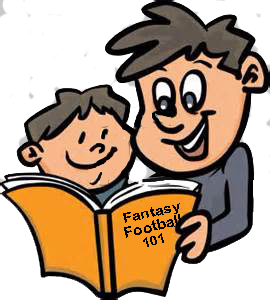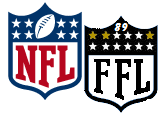Franchise Football League
est 1989
Fantasy Football Dictionary

ADD
Adding a free-agent player off the waiver wire.
AUCTION DRAFT
Owners take turns nominating players, who are then bid on by all owners. Each owner is given a spending limit (or salary cap) to complete their roster. This formula was popular in many early fantasy leagues and is still used today, although a snake/serpentine draft has become the most common way to fill out a roster.
ADP (AVERAGE DRAFT POSITION)
This report lists the average round in which a player is typically chosen during a fantasy football draft. NFL.com fantasy leagues will give a report based on the results of the numerous drafts that already have taken place.
BASIC SCORING SYSTEM
The most basic scoring systems award points only for touchdowns, field goals and extra points. That could be six points for all touchdowns, three points for field goals and one point for extra points. Other basic scoring leagues will offer four points for touchdown passes. More advanced leagues will offer scoring bonuses for players hitting yardage markers, such as 250 passing yards or 100 rushing yards. Some exotic leagues will base points on length of touchdown scores, field goals, etc.
BEST BALL LEAGUES: (Draft-Only)
A league where there are no weekly head-to-head matchups between fantasy owners' teams; the fantasy team with the most points at the end of the season wins. These leagues are most traditionally draft-only leagues.
BREAKOUT
A player who goes from average to full-fledged fantasy football star. Browns WR Josh Gordon, for instance, was a breakout star in 2013, going from the waiver wire to Fantasy All-Star with 1,646 receiving yards and 9 touchdowns.
BUST
A player who enters the season with high expectations but finishes with minimal statistical results. RB Arian Foster and WR Hakeem Nicks were two examples of players who failed to live up to high expectations coming into the 2013 season.
BYE WEEK
NFL teams play 16 games in 17 weeks, with a bye week mixed in somewhere. Being cognizant of bye weeks is very important when constructing a fantasy football team. As a result, you don't want to draft two quarterbacks with the same bye week because this will force you to go deep into the waiver wire for an emergency starter. For example, if you draft Peyton Manning (Week 7), you don't want to draft Matt Schaub or Mark Sanchez, who share the same bye week.
CHEAT SHEET
A prepared list of players ranked in order of fantasy value. When putting together a cheat sheet, be aware of your league's scoring system and rank your players accordingly.
COMEBACK PLAYER
A player who returns from a significant injury and re-emerges into a legitimate fantasy starter (i.e. Aaron Rodgers is a "comeback player" candidate in 2014 after his injury in 2013).
CUSTOM-SCORING LEAGUE
A league that decides to assign its own value to touchdowns, field goals, extra points, etc. For instance, some leagues will give bonus point values for rushing or receiving game milestones. This is why it's important to know what type of scoring your league uses when you draft your team. NFL.com Fantasy Football 2010 allows you to customize more than 100 scoring settings and features.
DEPTH CHART
An NFL roster split that shows first-, second- and third-string players. For instance, Colin Kaepernick is first string at running back on the Niners' depth chart, and Blaine Gabbert is second. That's something important to keep in mind when you look at handcuffs (for the explanation of that term, look below).
DEVY LEAGUES:
A devy league is a specific form of a dynasty league which allows owners to draft and roster developmental players, often referred to as “devys.” These developmental players are most often college players.
DRAFT
Most fantasy football teams are constructed via a draft, where owners take turns picking players for the upcoming season. Most drafts orders are constructed through a random drawing or are based on the previous year's results, with the poorest teams drafting first.
DRAFT DASHERS
People who enjoy drafting a fantasy football team but disappear long before the season is over, abandoning their team. At NFL.com, we do not have those types of owners.
DROP
Releasing a player back into the free-agent pool.
DYNASTY LEAGUE
This is similar to a "keeper league", but instead of a few players being held over, an entire roster is retained. This league calls for a long-term commitment, but it also makes each draft run much smoother as only a few players will be picked.
FAAB:
Free Agent Acquisition Budget, a set dollar amount to use over the course of a season on free agents.
FIRE SALE
When a team's season is lost and they cannot make the playoffs, owners of teams sometimes like to trade away their stud players to boost another team's chances of winning the championship.
FLEX POSITION
A extra position set by the league rules. Flex can be set by a number of setups. Flex RB-WR, WR-TE, RB-WR-TE, or QB-RB-WR-TE
FLIER
Taking a gamble on a player (either in the draft or off the waiver wire) who has high potential but also carries a high risk. Many times, this can be a backup quarterback, backup running back, a player coming off an injury, or a rookie. Some owners took a "flier" on RB Le'Veon in the draft last season and reaped the rewards of the decision. However, these results aren't typical for most fliers. Normally, you end up releasing them or they sit on your bench for the entire season
FREE AGENT
A player who isn't on a team's roster and is available on the waiver wire.
HANDCUFF
Taking the immediate backup for one of your prominent players. If you have RB Frank Gore, for instance, you would be wise to handcuff him by drafting Marcus Lattimore, too.
IDP
Some leagues will use the stats of individual defensive players, or IDPs, instead of using team defenses. Scoring can vary but typically includes point values for sacks, safeties and interceptions. If your league uses IDPs, be sure to add them to your cheat sheet. IDP's are available in custom leagues on NFL.com.
INJURED RESERVE
Some leagues will allow you to tag an injured player and add someone else to your roster. This is more common with dynasty and keeper leagues, but some seasonal leagues also use that option. 2020 - Added Covid - IR and OO - opted out of season.
KEEPER LEAGUE
These leagues allow you to keep a certain number of players each season. The number of keepers varies from league-to-league. Some leagues, called "dynasty leagues," allow you to keep your entire roster.
LEAGUE ALMANAC
A quick view of past league champions from previous seasons. You can also see who scored the most points as a team during a week in any given season.
LEAGUE HISTORY
An area to look at how your team and your opponents faired in previous years. Want to see who took home the championship in 2013? Everything you want to know is right at your fingertips.
LEAGUE MANAGER / SECRETARY
The person in charge of running the league, setting up the draft and, if necessary, controlling all of the league fees. Other tasks, such as updating results and standings, are provided by the web host site. The league manager also can have the final word on all transactions and disputes between owners.
LINEAR DRAFT
Just like the actual draft in NFL, NFL.com Fantasy Football now offers a "linear" draft. This is available in custom leagues. In this type of draft, the draft order in Round 1 repeats itself throughout the draft. If you have the last pick in the first round, you will have the last pick in the second round and so forth.
MOCK DRAFT
A "fake" fantasy draft that isn't played out during the season but often is used by team owners to practice drafting and prepare in advance. NFL.com Fantasy Football offers mock drafts, Click Here.
ORPHAN TEAM: An orphan dynasty team is simply a fantasy football team in an ongoing dynasty league that has been abandoned by its owner. Once abandoned, the team is labeled as an “orphan” and goes up for sale. The orphan teams will continue to play in their dynasty leagues and compete for cash prizes!
OWNER
The person who runs his/her own fantasy team and ultimately is responsible for making all personnel decisions.
PERFORMANCE SCORING SYSTEM
A scoring system in which players are given bonus points for passing, rushing and/or receiving milestones. For instance, some leagues will award one point for every 10 rushing yards. Or they might give five points for every 300 passing yards in addition to basic scoring.
PPR (POINT PER RECEPTION)
Indicates a league that awards a point per reception. Typically, running backs, wide receivers and tight ends all receive the same number of points for catches, but some leagues award staggered bonuses based on position. For example, running backs could receive .5 points per reception, while wideouts and tight ends receive a full point.
PROJECTIONS
A player's predicted statistics, which are used to help determine that player's fantasy value.
RANDOM ORDER DRAFT:
Each round has a different draft order. Draft order is determined by a program or there are many fantasy sites that have draft order tools.
RBBC (RUNNING BACK BY COMMITTEE)
A dirty four-letter phrase in the world of fantasy football, RBBC describes a situation in which an NFL team uses more than one running back in a prominent role. A perfect example exists in New England, where Shane Vereen and Steven Ridley are rotated throughout the game. This scenario sometimes makes it difficult for owners to depend on a back for a consistent level of production. RBBCs have become much more popular in recent seasons and have made featured backs such as Adrian Peterson and Jamaal Charles even more valuable in drafts -- and just as rare.
RESERVE
Backup or bench players.
ROSTER
The list of players on your team.
ROOKIE DRAFT:
Drafts that only draft rookies, the same as the NFL draft. Number of rounds are determined by each fantasy league or to even have one.
RULE BOOK / OWNER:
Set of rules that govern how the league will be
run. There's two types of owners: 1. Knows the
rule book and if unsure will check the rule book for the answer. If still unsure then will ask the commissioner for a clarification. 2. Thinks or guess's about a rule and is lazy or does not want to take the time to read the rule book. Often makes several mistakes in a season. Of which the mistake is not their fault.
I would hope this tip mostly goes without saying, but unfortunately, I must repeat it. Every league has slightly different rules and scoring settings. Understanding the scoring settings relates to my start/sit tip from earlier, but there are also other rules in each dynasty league. For example, every league handles taxi squads differently. In some leagues, the taxi squad locks at the start of the season. In others, you can promote and demote all rookies freely at any time, and sometimes, you can demote players once but can never demote them again once you’ve promoted them. All of these rules should be in your league by-laws, so it’s essential to take a look at those before the season kicks into high gear.
SEASON LEAGUES (REDRAFT LEAGUES)
Leagues start new every year. All players return to the draft pool after the previous season ends.
SNAKE OR SERPENTINE DRAFT
Unlike the actual NFL draft, most fantasy drafts use the "snake" system in which the team with the first pick in Round 1 has the last pick in Round 2, followed by the first pick in Round 3. Conversely, the team with the last pick in the first round has the first pick in the second round. This system is used to help create a balance between all of the competing teams. There often is a great debate as to which draft position is best, but that has yet to be settled.
SLEEPER
Typically, a late-round pick or waiver-wire selection who exceeds his statistical expectations and becomes a prominent option in fantasy leagues. A sleeper can be a rookie, such as Anquan Boldin in 2003, or a player who has yet to live up to his potential, like Jeremy Maclin. Third-year wide receivers often are good candidates to be sleepers because many take a couple of years to develop.
STARTING LINEUP
Most basic leagues will allow owners to start one quarterback, two running backs, two or three receivers and one tight end, one kicker and one defense. Leagues can determine the number of starters and include a "flex" position that can be a running back, a wide receiver or a tight end. Some leagues also use individual defensive starters.
STREAMING
A strategy of picking up and dropping a new player each week based on matchups. This is most commonly done with positions that require one roster spot (QB, TE, K, D/ST). Most fantasy owners don't draft backups at these positions, and as a result, there are typically viable options available on the waiver wire
STUD
A true superstar at his position. Drew Brees, Adrian Peterson and Calvin Johnson are bona fide studs. Matthew Stafford? A good fantasy performer, but not a fantasy stud.
SUPER BOWL SLUMP
Players from the previous Super Bowl losing team always seem to struggle the next season. Following this, be wary of Bronco players.
SUPERFLEX DRAFT
A fantasy football league that includes a flex roster spot in which you may start a quarterback, offering fantasy owners the flexibility to start two quarterbacks each week.
TEAM QB
Instead of drafting individual quarterbacks, teams essentially take every quarterback on a given team. For instance, if you draft the Patriots as your Team QB, you have Tom Brady and Ryan Mallet. If you draft the Broncos as your Team QB, you have Peyton Manning and Brock Osweiler. Fantasy purists argue that this system is as evil as the designated hitter in Major League Baseball. Accounting for player's injuries is part of the strategy of the game, and you lose something with Team QBs.
THIRD-YEAR WIDE RECEIVER
Much like Harold Carmichael, Santana Moss and Steve Smith (to name a few), some receivers fail to make an impact until their third NFL season. Third-year receivers are great candidates to be "sleepers" and have "breakout" years.
TRADE
A transaction that involves the swapping of one or more players from one team to another. In some fantasy leagues, the commissioner has the power to approve or deny all trade requests. A voting process among owners is also used in leagues.
TRANSACTION
Any roster change (waiver-wire add/drop, trade, etc.). Some leagues limit the amount of transactions a team can make, often charging money for excessive moves.
UNDROPPABLE
NFL.com keeps an updated list of players that cannot be dropped from an owners team. This is done to protect the integrity of the league. This is updated frequently so if a player is hurt and lost for the season, they will be removed from the list and owners are free to drop them if they wish.
WAIVER HAWK
Some players don't want to sacrifice waiver position to pick up players, so they wait until the early morning hours to make roster moves just minutes after a player clears waivers.
WAIVER ORDER
Refers to the order that established at the end of each week barring your league settings. The higher you are on the waiver order, the better chance you have to claim a player on the waiver wire.
WAIVER WIRE
Refers to the list of free-agent players within a fantasy league. Most free agents are subject to a waiver process, as a player is placed on waivers after the kickoff of the first game of the week or during a designated period (24 hours) after being released from a team. Waivers help to ensure that all teams have the opportunity to claim the best free agents, resulting in more balanced, competitive leagues.





